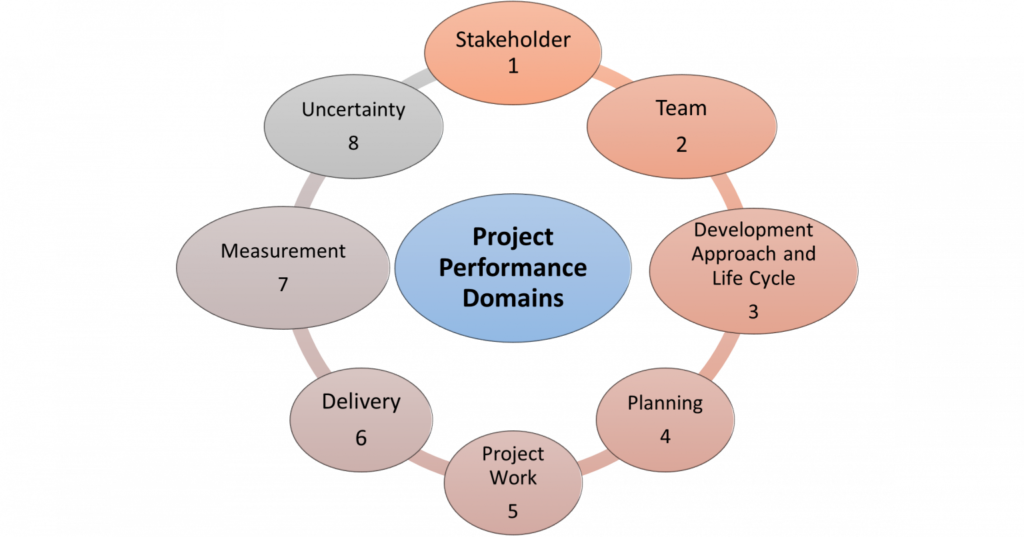The Project Performance Domains are a group of related activities that are critical for the effective delivery of project outcomes. Project performance domains are interactive, interrelated, and interdependent areas of focus that work in unison to achieve desired project outcomes.
Each domain covers specific activities that project managers should perform. For example, under the stakeholder management domain, activities include identifying stakeholders, planning communication approaches, and managing stakeholder expectations
If Principles are Questions then performance domains are answers. Every performance domain links with every Principle. Take the example of the team performance domain, if you don’t build a collaborative culture, you will have quality issues, you won’t be able to focus on value and that would hurt a stakeholder’s trust.

Project Performance domains are
- Are areas of focus for delivering projects
- They are interdependent, interrelated, and overlapping
- They occur throughout the project life cycle
- They are outcomes-focused
All these eight performance domains can be applied to any methodology critical chain, to Kanban, to FEL, to extreme programming, to ITIL.
Project Performance domains are not Process
- Stakeholder: This domain focuses on identifying stakeholders and their needs and expectations. It also involves managing stakeholder engagement throughout the project life cycle. When everyone is working together, the project will be successful. The Principle of Stakeholder focuses on Engaging and here it is focused on how to engage.
- Team: This domain focuses on building and managing an effective project team. It includes developing team roles and responsibilities, managing team performance, and resolving conflicts. This is about making sure that the people who are working on the project are doing their best work. We want to make sure that they are all working together and doing what they need to do to make the project great. We should build a positive team culture. The team is a human side of project management so Emotional Intelligence and Soft skills play a vital role in team building
- Development Approach & Life Cycle: This domain focuses on selecting an appropriate development approach and life cycle for the project. It includes selecting a development approach (e.g., predictive or adaptive) and life cycle (e.g., waterfall or agile) that aligns with stakeholder needs and expectations. We need to pick the best way to do the project based on what we want to make and how we want to make it. If the outcome is clear and the product is visualisable with clear prototypes, go for the predictive approach. This is a great addition to PMBOK 7, it does not force you to select one.
- Planning: This domain focuses on developing a comprehensive project plan that guides project execution. It includes defining project objectives, creating a project management plan (PMP), and developing a budget. This is costing, budgeting, Team identification, stakeholder engagement, scope identification, etc
- Project Work: This domain focuses on the work that needs to be done to deliver the project outcomes. It includes defining the project scope, creating a work breakdown structure (WBS), and developing a schedule. We want to make sure everyone is communicating well and that everything is going smoothly. This is heavily dependent on the development approach you selected earlier. This is where the tailoring concept would be heavily used.
- Delivery: This domain focuses on delivering project outcomes that meet stakeholder needs and expectations. It includes monitoring and controlling project work, managing changes to project scope, schedule, and budget, and ensuring quality.
- Measurement: This domain focuses on measuring project performance against the project management plan (PMP). It includes collecting data on project performance, analyzing data to identify trends and issues, and reporting progress to stakeholders. If there were any problems, we want to figure out what went wrong and how we can do better next time. OKRs, KPIs, MBO’s all are part of the performance of the project.
- Uncertainty: This domain focuses on managing uncertainty and risk throughout the project life cycle. It includes identifying risks, assessing their impact and probability, and developing risk response strategies.
In conclusion, successful project management involves many different domains. Stakeholder engagement is important for understanding everyone’s needs and working together. The project team needs to work well together and communicate effectively. Managing risks and uncertainties is also important to ensure project success. Delivering project outcomes that meet stakeholder needs and expectations is crucial. Developing a comprehensive project plan and selecting an appropriate development approach and life cycle are also important. Finally, measuring project performance helps identify any problems and figure out how to do better next time. By focusing on these domains, project managers can help ensure project success.


One thought to “Project Performance Domains”
Pingback: The Standard of Project Management and PMBOK 7 - Mudassir Iqbal, PMP